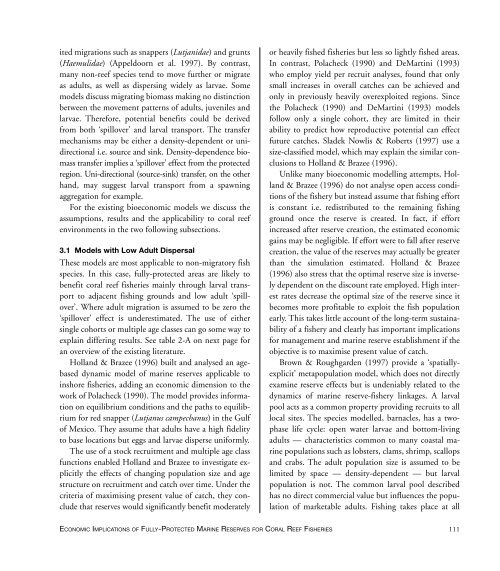You also want an ePaper? Increase the reach of your titles
YUMPU automatically turns print PDFs into web optimized ePapers that Google loves.
ited migrations such as snappers (Lutjanidae) and grunts<br />
(Haemulidae) (Appeldoorn et al. 1997). By contrast,<br />
many non-reef species tend to move further or migrate<br />
as adults, as well as dispersing widely as larvae. Some<br />
models discuss migrating biomass making no distinction<br />
between the movement patterns <strong>of</strong> adults, juveniles and<br />
larvae. Therefore, potential benefits could be derived<br />
from both ‘spillover’ and larval transport. The transfer<br />
mechanisms may be either a density-dependent or unidirectional<br />
i.e. source and sink. Density-dependence biomass<br />
transfer implies a ‘spillover’ effect from the protected<br />
region. Uni-directional (source-sink) transfer, on the other<br />
hand, may suggest larval transport from a spawning<br />
aggregation for example.<br />
For the existing bioeconomic models we discuss the<br />
assumptions, results and the applicability to coral reef<br />
environments in the two following subsections.<br />
3.1 Models with Low Adult Dispersal<br />
These models are most applicable to non-migratory fish<br />
species. In this case, fully-protected areas are likely to<br />
benefit coral reef fisheries mainly through larval transport<br />
to adjacent fishing grounds and low adult ‘spillover’.<br />
Where adult migration is assumed to be zero the<br />
‘spillover’ effect is underestimated. The use <strong>of</strong> either<br />
single cohorts or multiple age classes can go some way to<br />
explain differing results. See table 2-A on next page for<br />
an overview <strong>of</strong> the existing literature.<br />
Holland & Brazee (1996) built and analysed an agebased<br />
dynamic model <strong>of</strong> marine reserves applicable to<br />
inshore fisheries, adding an economic dimension to the<br />
work <strong>of</strong> Polacheck (1990). The model provides information<br />
on equilibrium conditions and the paths to equilibrium<br />
for red snapper (Lutjanus campechanus) in the Gulf<br />
<strong>of</strong> Mexico. They assume that adults have a high fidelity<br />
to base locations but eggs and larvae disperse uniformly.<br />
The use <strong>of</strong> a stock recruitment and multiple age class<br />
functions enabled Holland and Brazee to investigate explicitly<br />
the effects <strong>of</strong> changing population size and age<br />
structure on recruitment and catch over time. Under the<br />
criteria <strong>of</strong> maximising present value <strong>of</strong> catch, they conclude<br />
that reserves would significantly benefit moderately<br />
or heavily fished fisheries but less so lightly fished areas.<br />
In contrast, Polacheck (1990) and DeMartini (1993)<br />
who employ yield per recruit analyses, found that only<br />
small increases in overall catches can be achieved and<br />
only in previously heavily overexploited regions. Since<br />
the Polacheck (1990) and DeMartini (1993) models<br />
follow only a single cohort, they are limited in their<br />
ability to predict how reproductive potential can effect<br />
future catches. Sladek Nowlis & Roberts (1997) use a<br />
size-classified model, which may explain the similar conclusions<br />
to Holland & Brazee (1996).<br />
Unlike many bioeconomic modelling attempts, Holland<br />
& Brazee (1996) do not analyse open access conditions<br />
<strong>of</strong> the fishery but instead assume that fishing effort<br />
is constant i.e. redistributed to the remaining fishing<br />
ground once the reserve is created. In fact, if effort<br />
increased after reserve creation, the estimated economic<br />
gains may be negligible. If effort were to fall after reserve<br />
creation, the value <strong>of</strong> the reserves may actually be greater<br />
than the simulation estimated. Holland & Brazee<br />
(1996) also stress that the optimal reserve size is inversely<br />
dependent on the discount rate employed. High interest<br />
rates decrease the optimal size <strong>of</strong> the reserve since it<br />
becomes more pr<strong>of</strong>itable to exploit the fish population<br />
early. This takes little account <strong>of</strong> the long-term sustainability<br />
<strong>of</strong> a fishery and clearly has important implications<br />
for management and marine reserve establishment if the<br />
objective is to maximise present value <strong>of</strong> catch.<br />
Brown & Roughgarden (1997) provide a ‘spatiallyexplicit’<br />
metapopulation model, which does not directly<br />
examine reserve effects but is undeniably related to the<br />
dynamics <strong>of</strong> marine reserve-fishery linkages. A larval<br />
pool acts as a common property providing recruits to all<br />
local sites. The species modelled, barnacles, has a twophase<br />
life cycle: open water larvae and bottom-living<br />
adults — characteristics common to many coastal marine<br />
populations such as lobsters, clams, shrimp, scallops<br />
and crabs. The adult population size is assumed to be<br />
limited by space — density-dependent — but larval<br />
population is not. The common larval pool described<br />
has no direct commercial value but influences the population<br />
<strong>of</strong> marketable adults. Fishing takes place at all<br />
ECONOMIC IMPLICATIONS OF FULLY-PROTECTED MARINE RESERVES FOR CORAL REEF FISHERIES<br />
111


















